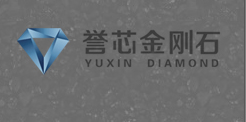Company tel:+86-379-63184520
Contact number:+86-15937921751
Postcode:471000
Email:info@yuxindiamond.com
Address:3-1-508 Luoyang National University Science Park, No. 2 Penglai Road, Jianxi District, Luoyang, China 471000
The World's First Technology for Bonding Single-crystal Diamond to a SiC Substrate at Room Temperature
Fujitsu and Fujitsu Laboratories have succeeded in developing the world’s first technology for room-temperature bonding onto a SiC substrate single-crystal diamond, used for high-efficiency cooling of GaN-HEMT power amps. These two hard materials have different coefficients of thermal expansion.
Background
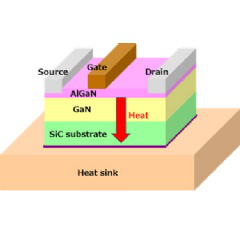
In recent years, high-frequency GaN-HEMT power amps have widely been used for long-range radio applications, such as radar and wireless communications. They are also expected to be used in weather radar that observes localized heavy rains, for example, or in the forthcoming 5G millimeter-band mobile communications protocols. For these types of radars or wireless communications using the microwave to millimeter-wave bands, by raising the output of the GaN-HEMT power amps used for transmissions, the distance that radio waves can propagate will allow the expansion of the observational range of radar while enabling longer and higher capacity communications. This is why GaN-HEMT power amps with higher power output are desirable.
Single-crystal diamond has extremely good thermal conductivity-almost five times that of a SiC substrate-and is known as a material that can efficiently spread heat. In order to bond a single-crystal diamond to a device as a cooling material, normal production processes use an Ar beam to remove impurities, which produces a low-density damaged surface that weakens the bonds the single-crystal diamond can form. Moreover, using SiN or other insulating films for bonding interferes with thermal conductivity due to SiN’s thermal resistance.
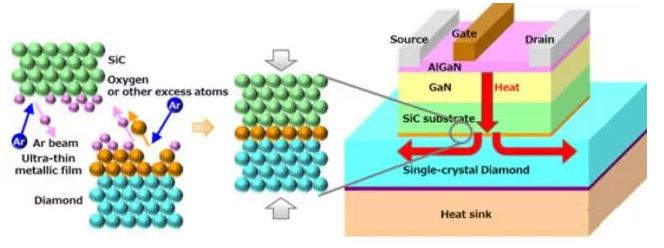
To prevent the Ar beam from forming a damaged layer on the diamond surface, the companies developed a technique that protects the surface with an extremely thin metallic film before it is exposed to the Ar beam. In order to ensure the surface is planar, for good bonding at room temperature, the metallic film is held to a thickness of 10 nm or less. This technology was confirmed to prevent the formation of the damaged layer on the diamond surface after Ar beam exposure, resulting in improved bonding strength and single-crystal diamond bonded at room temperature to a SiC substrate for GaN-HEMT.
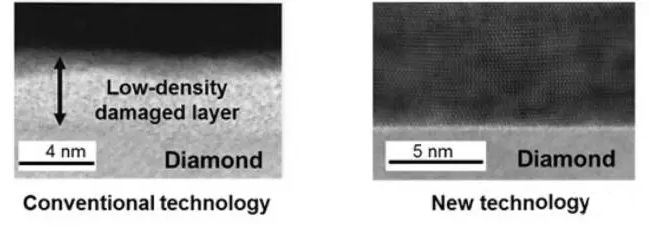
Now, by protecting the surface of the diamond with an extremely thin metallic film, Fujitsu and Fujitsu Laboratories succeeded in preventing the formation of the damaged layer and bonding single-crystal diamond to a SiC substrate at “room-temperature bonding”. Simulations using actual measurements of thermal parameters have confirmed that devices using this technology would lower thermal resistance to 61% of existing ones.
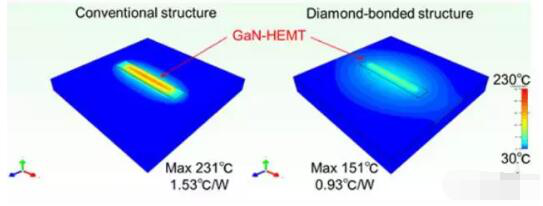
Use of this technology promises GaN-HEMT power amps for transmitters with even higher power output. When used in systems such as weather radars, GaN-HEMT power amps for transmitters could be expected to increase the radar’s observable range by a factor of 1.5. This would allow for quicker detection of the cumulonimbus clouds that can produce sudden rainstorms, and contribute to a safer and more secure society in terms of disaster readiness.
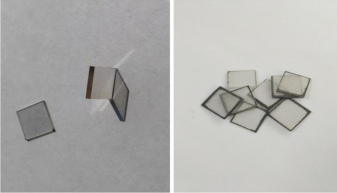
Luoyang Yuxin Diamond Co., Ltd’s CVD single crystal diamond is manufactured by Microwave Plasma Chemical Vapor Deposition. With good wear resistance, thermal conductivity and compressive resistance, high hardness and strength, low friction coefficient, excellent corrosion resistance and chemical stability, it can be sharpened into very sharp blade, and it is considered to be the most ideal ultra-precision cutting tool material, which occupies an important position and is widely used in the mechanical processing field especially the ultra precision processing field.
Features: used in ultra precision cutting tools, especially processing non-ferrous metal materials, such as aluminum (alloy), copper, high polymer materials (MMCs), carbon fiber reinforced plastics (CFPs) Parts surface can be the mirror effect, and its surface roughness can reach below Ra-0.1μm.

